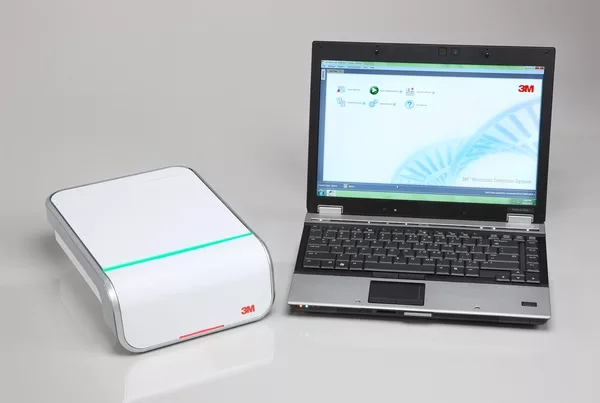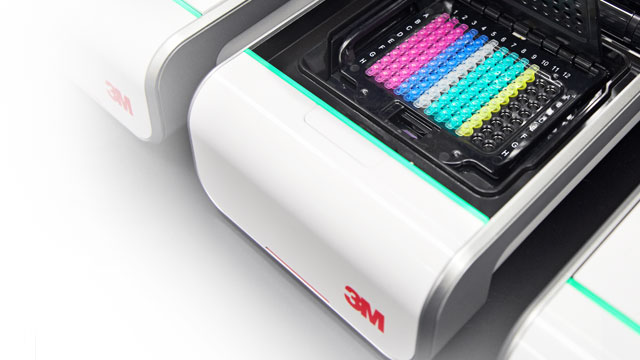Four Ways LAMP Technology Is Lighting Up Rapid Pathogen Testing

Earlier this year, the U.S. Department of Agriculture’s Food Safety and Inspection Service (USDA FSIS) revised its Microbiology Laboratory Guidebook (MLG), the official guide to the preferred methods the agency uses when testing samples collected from audits and inspections. Notably, the MLG updated the rapid methods surrounding Salmonella and Listeria monocytogenes testing (crucial for meat, poultry, fish, and egg producers) to feature the 3M™ Molecular Detection System.
3M’s DNA-based food safety test, based on loop-mediated isothermal amplification (LAMP) technology, is already used in more than 50 countries by food processors, contract laboratories, universities, and governments, has been referenced in thousands of peer-reviewed journal articles, and holds top international awards for innovation. However, the MLG’s new inclusion of the 3M system as a rapid method for Salmonella (the majority of its testing) and L. monocytogenes adds important new luster. After all, USDA has the power to cease operations and invoke recalls, and the ramifications of its testing reverberate worldwide.
The FSIS recently published results of the thorough evaluation it conducted on four different screening platforms after deliberately spiking a cross-section of USDA-relevant food types at a fractional recovery range of 20–80 percent. As it relates to the technology’s sensitivity and specificity (inclusivity and exclusivity) findings, 3M Molecular Detection System assays performed better or equivalent to the polymerase chain reaction (PCR) systems tested.
In many ways, the research signals that the LAMP technology that 3M has commercialized—fundamentally different than the approach much of the industry is using—is here to stay.
Back in 2011 when 3M first launched the technology, the industry was appreciating the value of rapid hygiene test systems predicated on ATP bioluminescence (e.g., the 3M Clean-Trace™ Monitoring and Management System) as a broad indicator of cleanliness and sanitation. At the same time, it was also using PCR DNA-based testing and its ability to replicate and measure target genetic material. Each method had its pros and cons. ATP testing existed as a simple and fast diagnostic tool but was not organism-specific. PCR brought the benefit of specifically detecting the gene codes of individual pathogens but with greater time, cost, and complexity.
 Recognizing the industry’s appetite for a pathogen detection solution as or more precise than PCR, but closer to the real-time simplicity and speed experienced with ATP testing, 3M scientists offered a solution incorporating an innovative combination of technologies—LAMP for DNA and bioluminescence detection. Early testing showed that the LAMP system enabled food safety technicians to generate more than one billion precise copies of target DNA from their samples—and to begin seeing presumptive positive results—as soon as 15 minutes into replication.
Recognizing the industry’s appetite for a pathogen detection solution as or more precise than PCR, but closer to the real-time simplicity and speed experienced with ATP testing, 3M scientists offered a solution incorporating an innovative combination of technologies—LAMP for DNA and bioluminescence detection. Early testing showed that the LAMP system enabled food safety technicians to generate more than one billion precise copies of target DNA from their samples—and to begin seeing presumptive positive results—as soon as 15 minutes into replication.
So what was the secret of LAMP technology? It comes down to four things:
-
It eliminates the need for thermal cycling. Thermocyclers, in many ways the backbone of PCR tests, alter temperature to facilitate a reaction. These components work by first melting and separating the two strands of a DNA double helix and subsequently cooling the genetic material so that primers can anneal to them. Thermocyclers can add a lot of expense to tests and include multiple moving parts or cooling fans that require maintenance and cleaning. Notably, during PCR, the melting and re-binding activities that amplify DNA happen repeatedly. In other words, for every food, beverage, or environmental surface sample tested, PCR systems will undergo multiple phases of heating up to 95 °C, cooling down to 60 °C, and then re-warming back to 72 °C. All of these temperature variations not only require more time to run and additional downtime in the lab, but they can also lead to interferences from other inhibiting substances that are native to a sample and co-extracted with the DNA. To mitigate this hinderance in detecting the pathogen under investigation and reduce the chances of false-negative results, PCR test providers incorporated internal amplification control (IAC) components. However, IAC brings its own set of problems: It adds bulk and complexity, and has been shown to sometimes compromise the accuracy of the test further.[1]
To avoid the delays, errors, and upkeep associated with the on-and-off cycling of PCR, LAMP amplifies DNA isothermally at a steady and stable temperature range—right around 60 °C. The continuous amplification it enables not only better tolerates the sample matrix inhibitors known to trip up PCR but allows LAMP’s instrumentation to be unconstrained of almost any moving piece, helping house the technology in a smaller machine and occupying less space on the workbench. -
It doubles the number of DNA primers and creates the “missing loop.” Traditional PCR tests recognize two separate regions of the target genetic material. They rely on two primers to anneal to the subject’s separated DNA strands and then copy and amplify that target DNA.
In contrast, LAMP technology uses four to six primers, which can recognize six to eight distinct regions from the sample’s DNA. These primers and the polymerase used not only cause the DNA strand to displace, it actually loops the end of the strands together before being amplified. This unique looped structure both accelerates the reaction and increases test result sensitivity by allowing an exponential accumulation of target DNA. -
It removes steps from the workflow. Before any genetic amplification can happen, technicians must enrich their
 samples to deliberately grow microorganisms to detectable levels. However, technicians using PCR tests have also had to pre-dispense lysis buffers or reagent mixes, and take other careful actions to extract and purify their DNA samples. Not surprisingly, these activities often lack controls, and they create the ongoing and unsettling possibility of human error and cross-contamination.
samples to deliberately grow microorganisms to detectable levels. However, technicians using PCR tests have also had to pre-dispense lysis buffers or reagent mixes, and take other careful actions to extract and purify their DNA samples. Not surprisingly, these activities often lack controls, and they create the ongoing and unsettling possibility of human error and cross-contamination.
Commercialized LAMP assay kits, on the other hand, offer more of a ready-to-use approach that don’t necessarily require buffers or reagent mixes to further prepare a sample. With the 3M Molecular Detection System, for example, lab technicians simply transfer their enriched sample to the lysis tube, heat and cool it, and then pipette their lysed sample to another tube before performing the test. By only requiring two transfer steps, it significantly reduces the risk of false negatives caused by erroneous laboratory preparation. -
It converts multiple test protocols into a single method. Food safety lab professionals using PCR technology have historically been required to perform different test protocols for each individual pathogen, whether that be Salmonella, Listeria, Escherichia coli O157:H7, etc. Not surprisingly, manufacturers have complained that this confounded their safety testing and drastically increased the chances of error. Oftentimes, their labs were resource-challenged and pressure-packed environments, and having to keep multiple testing steps straight all of the time was a recipe for trouble.
LAMP brought the benefit of a single assay protocol for all pathogens. It enabled technicians to use the same familiar process for all pathogen tests, even concurrently testing different pathogens in the same run by being able to batch process up to 96 different samples at once. To make the system still easier to use, 3M also color-coded its reagent tubes by organism type and used color-distinguished icons within its software to match the tubes. This streamlined workflow involving minimal accessories simplified the process and again reduced risk of human-caused error.
To learn more about 3M’s LAMP-based pathogen detection technology and its use by USDA FSIS as the primary method for detecting Salmonella and Listeria, visit 3M.com/PathogenDetectionTech.
1. https://www.sciencedirect.com/science/article/pii/S2214753515300097.
Looking for quick answers on food safety topics?
Try Ask FSM, our new smart AI search tool.
Ask FSM →





